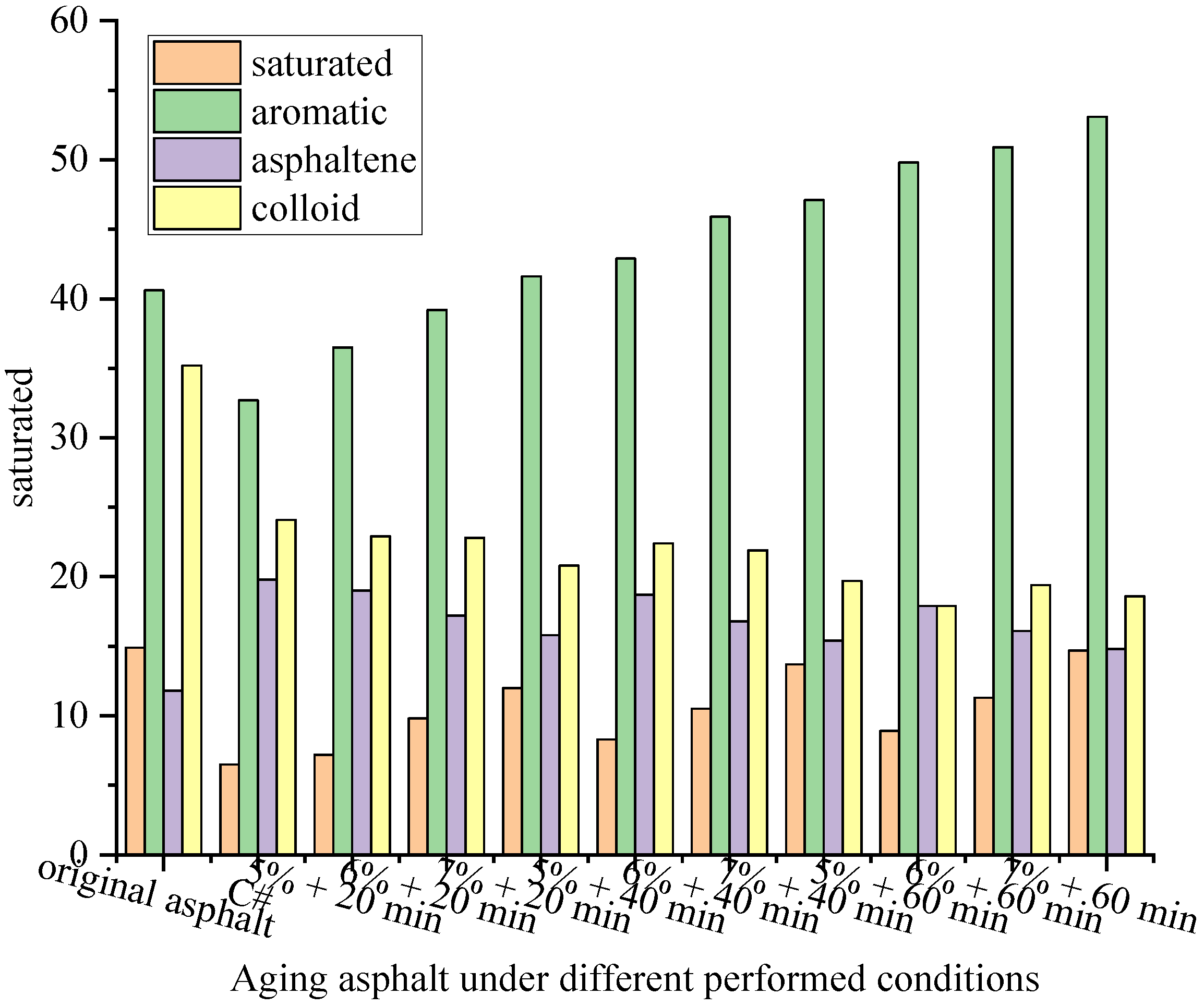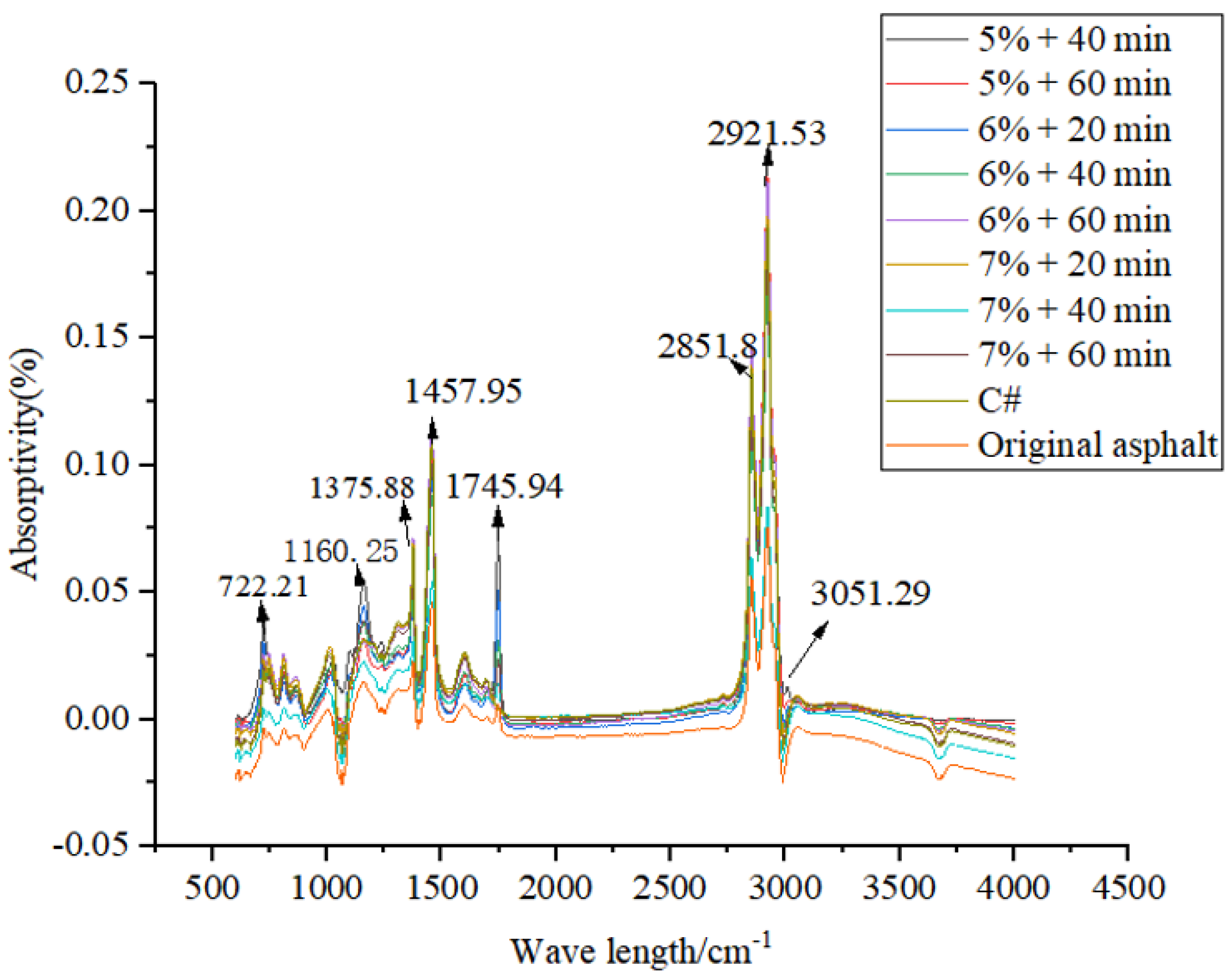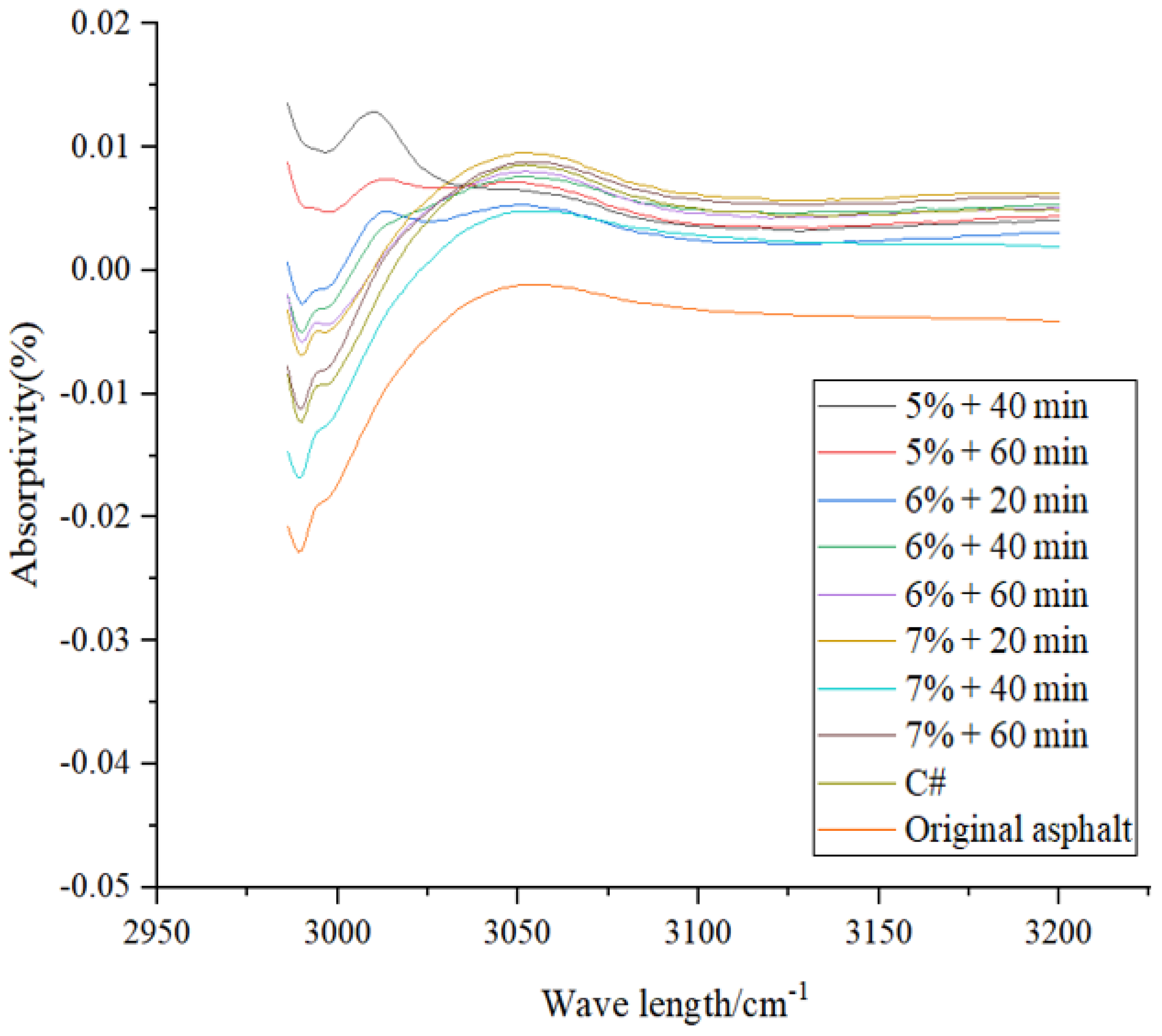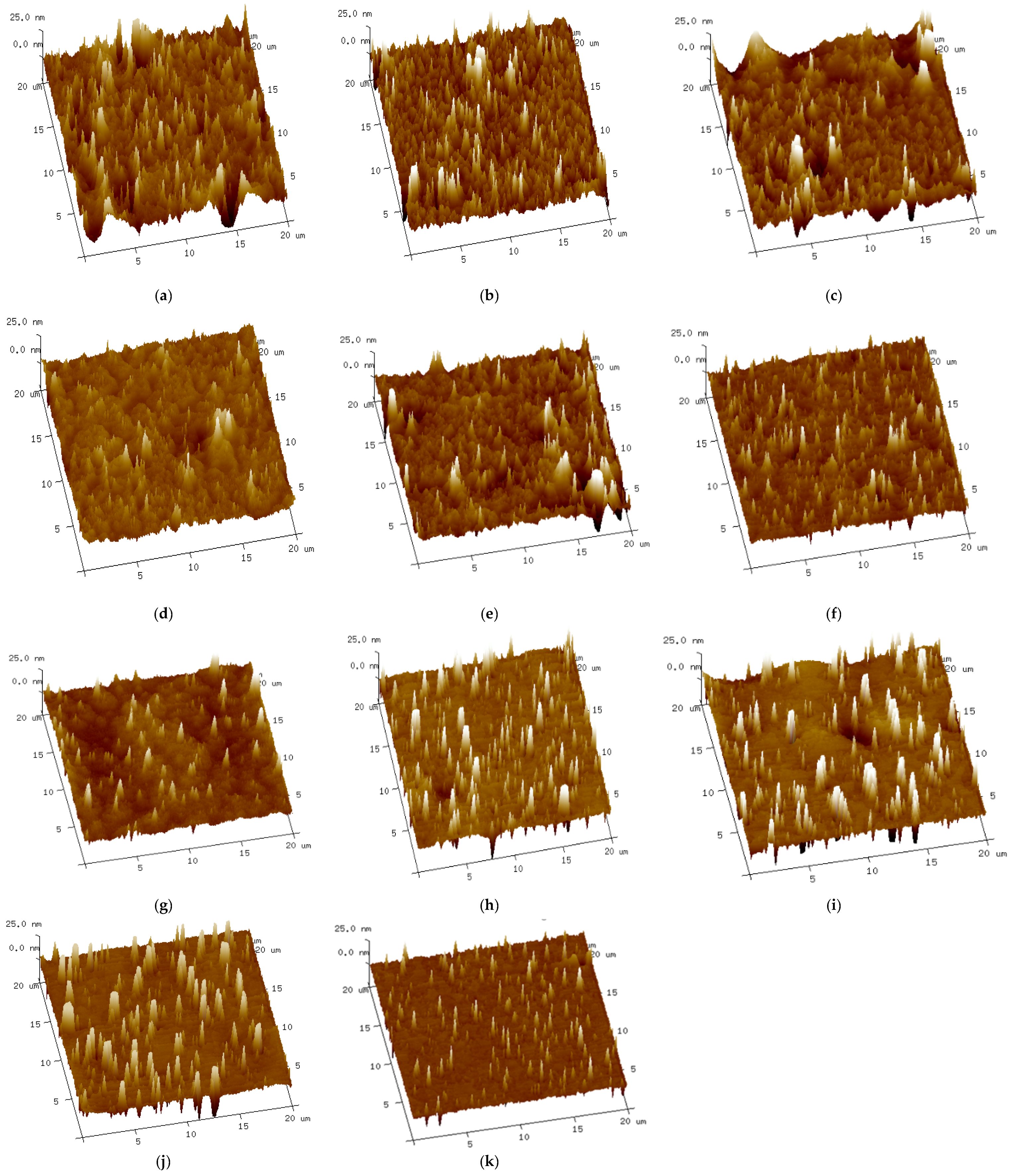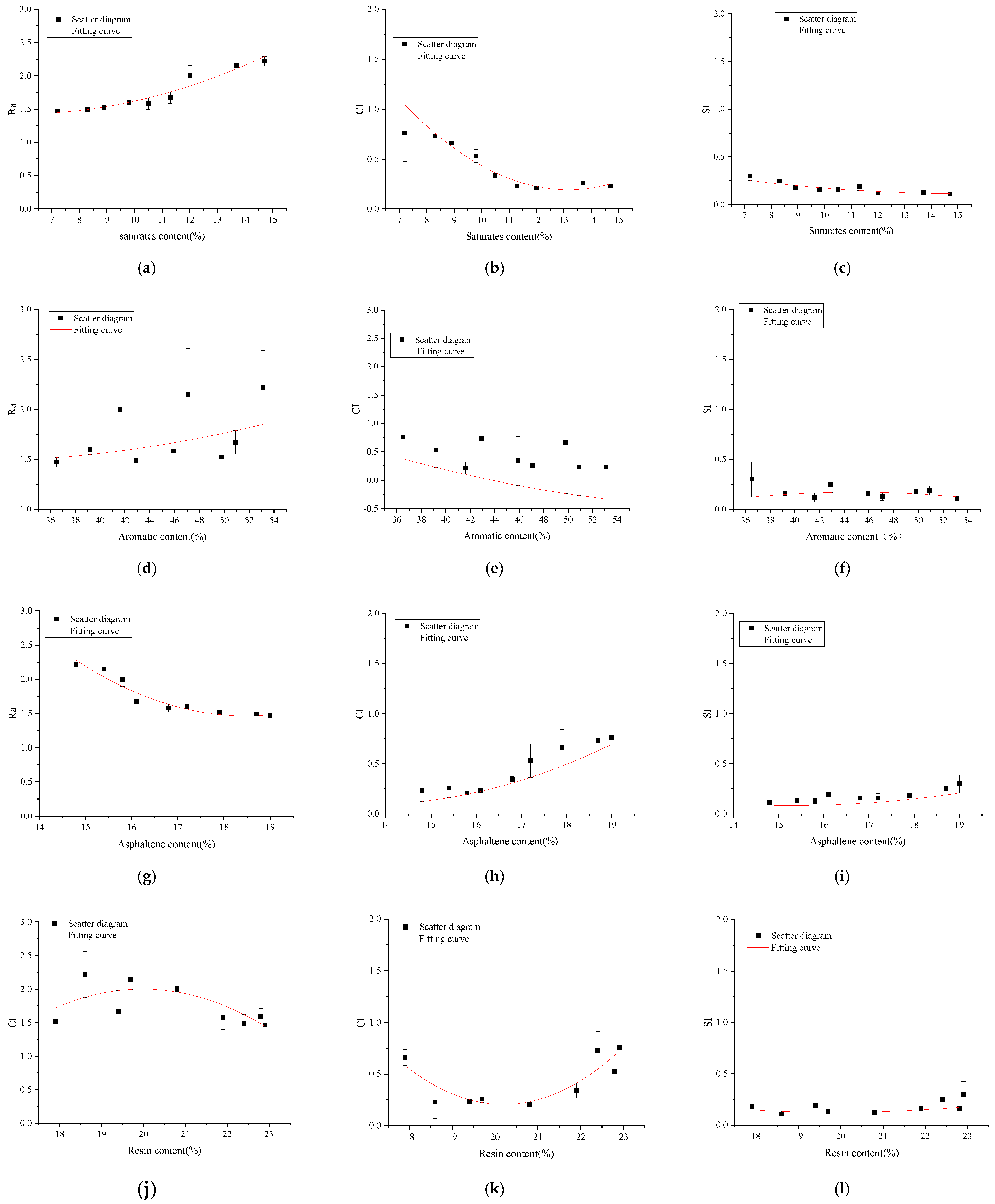1. Introduction
The aging phenomenon of asphalt material is affected by ultraviolet radiation, temperature, rain, and other factors during the use of asphalt pavement. Due to environmental factors such as alternate temperature changes in the four seasons, the micro-morphology of the asphalt material will also change, resulting in obvious changes in the macroscopic performance indexes such as the softening point, ductility, and viscosity of asphalt during aging, and shortening the service life of the pavement [
1]. Asphalt is a very complex chemical material. The changes in its four components, content, molecular weight, functional groups, and other chemical compositions have a fundamental impact on asphalt pavement performance [
2]. The esters of straight-chain higher fatty acids and glycerol is not volatile at high temperature. Therefore, they can be used to recover the micro-chemical composition of bitumen and the change in colloidal stability of asphaltene [
3].
Qu [
4] and Menapace et al. [
5] separated matrix asphalt with different aging degrees of the Corbett separation method. The experiment concluded that with the decrease in aromatic content of asphalt in short-term aging, the asphaltene content increased. The chemical reaction occurred after the aging of matrix asphalt, and part of the aromatic content and resin became asphaltene. Xing et al. [
6] analyzed the changes in functional groups of matrix asphalt before and after aging by atomic force microscopy-infrared spectroscopy, and concluded that with the increase in aging, the content of carbonyl and sulfoxide increased.
Exploring the changes in asphalt performance before and after aging mainly serves to improve the regeneration ability of aging asphalt. The waste edible oil regeneration agent [
7], waste oil regeneration agent [
8], and waste bio-oil regeneration agent [
9] are three kinds of products with great transformation potentials to realize large-scale industrial production and practical application. Among them, the main raw materials of the waste edible oil regeneration agent are recycled waste cooking oil [
10] and expanded food production waste oil as the representative, and the main raw materials of the waste biological oil regeneration agent are waste tung oil [
11] and cotton seed oil [
12] as the representative. The main raw materials of the waste oil regeneration agent are motor vehicle waste oil [
13] and waste hydraulic oil [
14]. These oils are rich in a variety of small-molecule organic compounds, which can be mixed with recycled asphalt to compensate for the lack of light components caused by the aging of asphalt to achieve regeneration.
The effects of the vegetable oil regeneration agent on the performance of aging asphalt in terms of the physical properties, the rheological properties, and the road performance of aging asphalt were analyzed by Leng [
15], Hugener [
16], and Chen [
17] compared with waste vegetable oil and mineral oil. The results showed that the regeneration effect of the former is better than that of the latter, in terms of the regeneration degree of aging asphalt regenerated by the vegetable oil regeneration agent. Somé [
18] compared the amount of aging asphalt regenerated by the vegetable oil regeneration agent and mineral oil regeneration agent to the same level, and they found that the amount of mineral oil regeneration agent was three times that of the vegetable oil regeneration agent.
Based on the above research results at home and abroad, waste vegetable oil was used as a regeneration agent for regenerated wet aging asphalt at room temperature. There is little research on the influence and correlation of waste vegetable oil as a regeneration agent on the composition and micro-morphology characteristics of aging asphalt through laboratory experiments. The research results have positive significance for the development of cold regeneration for aging asphalt.
3. Results
3.1. Regeneration of Wasting Vegetable Oil
By comparing the test results of physical performance indexes such as the softening point and penetration of original asphalt and waste vegetable oil recycled asphalt in
Table 3 and
Table 5, it can be found that after the regeneration effect of waste vegetable oil, the softening point and viscosity of aging asphalt decreased with the regeneration time and agent content, and the penetration and ductility increased with the regeneration time and agent content. When the waste vegetable oil content was 7.0% and the regeneration time was 60 min, the softening point at this time was restored to 80% of the original asphalt, the penetration was restored to about 75% of the original asphalt, and the ductility and viscosity were restored to more than 90% of the original asphalt. At this time, the physical performance was best.
3.2. Change in Aging Asphalt Composition
Under the same regeneration time, the saturated and aromatic contents increased linearly with the regeneration content, while the asphaltene and resin contents decreased with fluctuations. With the increases in the regeneration content and time, the saturated content of regenerated aging asphalt increased linearly as a whole, the aromatic content fluctuated, the asphaltene content decreased linearly, and the resin content decreased. When the dosage of the waste vegetable oil regeneration agent was 7.0% and the regeneration time was 60 min, the saturated and aromatic contents of regenerated aging asphalt were highest, which were 2.3 times and 1.6 times the original aging asphalt, respectively. The asphaltene and resin content of the regenerated aging asphalt decreased to varying degrees compared with the original aging asphalt, and the overall negative growth. When the dosage of the waste vegetable oil regeneration agent was 7.0% and the regeneration time was 60 min, the negative increase in asphaltene content was most obvious. When the content of the waste vegetable oil regeneration agent was 5.0% and the regeneration time was 60 min, the negative growth of resin content was most obvious, and the asphaltene and resin content of the original aging asphalt were 1.3 times those of the regenerated aging asphalt. Compared with the original asphalt, when the waste vegetable oil content was 7% and the regeneration time was 60 min, the saturated content of the recycled aged asphalt was 0.9 times that of the original asphalt, which was basically the same as that of the original asphalt. The contents of aromatics and asphaltenes were 1.3 times those of the original asphalt, and the content of resin was 0.5 times that of the original asphalt.
During the aging process, the saturated and aromatic components of asphalt underwent aging reaction under the influence of high temperature, ultraviolet radiation, and other factors, which was converted into resin and then into asphaltene. Therefore, the asphaltene and resin contents of the regenerated aging asphalt were higher than those of the original asphalt. In the figure, the variation in asphaltene and resin showed negative growth. The content of asphaltene and resin decreased with the regeneration time and agent dosage, and the decrease in the two components was equivalent, with a change rate of 10–20%. Under the same amount of regeneration agent, when the regeneration time was 60 min, the content of the two-hour component of asphalt reached the minimum.
3.3. Test Results of Infrared Spectrometer
The peaks in the figures are common portions, of which the peaks of 3051.29 cm−1 represent the presence of the aromatic ring. The peaks of 2921.99 cm−1 and 2852.88 cm−1 represent the peaks caused by the vibration of the alphabetic group; 1745.94 cm−1 represents the peak caused by the vibration of the hydroxy functional group carbon–oxygen bond; according to the predecessors, the absorption peak of waste vegetable oil A is attributed to the carbonyl C=O in carbonate. The peak at 1457.96 cm−1 represents a saturated C=H key feature of the amide substance.
The peaks in the figure are the common part, in which the peak near 3050 cm−1 represents the existence of aromatic rings. At the dosage of 7.0% waste vegetable oil, the peak is relatively high, and the area of the absorption peaks decreases with the regeneration time. The peaks near 2920 cm−1 and 2850 cm−1 represent the vibrations of methylene symmetric and antisymmetric functional groups, and the peaks near 1745 cm−1 represent the vibrations of hydroxyl functional groups. Waste vegetable oil has the absorption peak of carbonyl C=O in carbonyl acid. Representative amides near 1460 cm−1 can be characterized by a saturated C=H bond. The vicinity of 1375 cm−1 represents the characteristic peak caused by methyl (−CH3) vibration. The peak near 1160 cm−1 represents the stretching vibration of C-F on the fluorine atom and benzene ring. The vicinity of 720 cm−1 represents the characteristic peak caused by the vibration of the methylene chain.
The characteristic peak near the wavelength of 3050 cm−1 indicates that there are aromatic rings. The peak is relatively high at a 7.0% waste vegetable oil content, and the area of the absorption peak decreases with the regeneration time.
With the increase in regeneration agent dosage and regeneration time, the CI value and SI value decreased. When the dosage of the waste vegetable oil regeneration agent reached 7.0% and the regeneration time was 40 min, the CI value and SI value showed an upward trend, and then with the increase in regeneration time, the CI value and SI value of aging asphalt decreased gradually, and the overall trend declined. When the dosage of the waste vegetable oil regeneration agent was 7.0% and the regeneration time was 20 min, the CI value and SI value of aging asphalt after regeneration reached the lowest value, which decreased by 71% and 58%, respectively, compared with aging asphalt. At this time, the CI value was 10.6 times that of the original asphalt, and the SI value was 2.6 times that of the original asphalt. Overall, the CI and SI values of aging asphalt with a waste vegetable oil content of 7% and regeneration time of 60 min were the closest to those of the original asphalt. This phenomenon indicated that the addition of waste vegetable oil inhibited the oxidation of benzyl and sulfide, weakened the interaction between polar functional groups in aging asphalt, and reduced the contents of carbonyl functional groups and sulfoxide functional groups. With the increase in the CI value and SI value, the aging degree of asphalt gradually increased.
3.4. Atomic Force Microscope Test Results
It can be seen from the red circle in
Figure 5 that the honeycomb structure of aging asphalt was basically not shown in (a). When the content of the waste vegetable oil regeneration agent was 5.0% and the regeneration time was 60 min, a few honeycomb structures could be observed in (d). In (e), (f), and (g), 6.0% of the waste vegetable oil regeneration agent content compared to the 5.0% honeycomb structure had a more concentrated distribution. When the dosage of the regeneration agent was 7.0%, it can be seen that the honeycomb structure was more obvious and the number significantly increased, and the distribution was more uniform. No honeycomb structure was found in aging asphalt without the waste vegetable oil regeneration agent. When the regeneration time was 60 min and the dosage of the waste vegetable oil regeneration agent was 5.0%, a few honeycomb structures were found and the honeycomb structure was not obvious (see the red ring outer section). With the increase in regeneration time and agent content, the honeycomb structure increased significantly. When the regeneration content of the waste vegetable oil was 7.0%, the honeycomb structure changed little with the increase in regeneration time, and the distribution range gradually expanded to be uniform.
The apparent 3D morphology diagram corresponds to the bee structure diagram. When the bee structure gradually increased, the peak number of asphalt surface bulges in the apparent 3D morphology diagram increased. When the dosage of the regeneration agent was 7.0%, the honeycomb structure was larger and the distribution was more standardized. Through (h), (i), and (j), it can be seen that the convex position distribution of each peak on the surface of aging asphalt was more uniform, which further shows that the recovery of the honeycomb structure had a direct impact on the apparent morphology of asphalt.
According to the calculation results above, the surface roughness of aging asphalt without waste vegetable oil was smallest. With the addition of the waste vegetable oil, the roughness of the asphalt surface increased. When the dosage of the waste vegetable oil regeneration agent was 7.0%, the Ra value increased with the regeneration time and reached the maximum value at 60 min. Compared with the Ra value of the original asphalt, the difference between the Ra value of waste vegetable oil and original asphalt was smallest when the content of waste vegetable oil was 7% and the regeneration time was 60 min.
Based on the above analysis, the optimal regeneration time of waste vegetable oil was 60 min, and the optimal regeneration content was 7.0%. At this time, the physical properties, microstructure analysis, and microstructure were well restored.
3.5. Correlation of Microstructure Characteristics of Aging Asphalt
The variations in component content in the aging process of the regenerated aging asphalt with different regeneration times and contents, carbonyl functional group indexes, and sulfoxide functional group indexes that characterize the aging degree of asphalt, and the average deviation of the contour arithmetic of roughness that characterizes the micro-morphology in the aging process were used to establish the models, respectively, by MATLAB software. The fitting effect of each model is shown in
Figure 8.
Optimal models of component content and microscopic characteristics of the waste vegetable oil-regenerated aging asphalt were established. Among them, the fitting effect of saturates content of the regenerated aging asphalt and CI representing the aging degree of asphalt was best, and the correlation coefficient reached 0.959. The correlation between the saturates content, asphaltene content, and their quantitative index of microscopic morphology characteristics was above 0.5, indicating that the change in saturates content and asphaltene content had the greatest correlation with the microscopic morphology characteristics. The fitting effect of aromatic content of the regenerated aging asphalt with SI was worst, and the correlation coefficient was only 0.114. The correlation with other microscopic morphology characteristics was all below 0.5, indicating that the change in aromatic content had little correlation with its microscopic morphology characteristics. The fitting effect of regenerated aging asphalt resin content with CI was relatively good, with a correlation coefficient of 0.697, and the fitting effect with SI was poor, with a correlation coefficient of only 0.203, indicating that the change in resin content had a good correlation with the carbonyl functional group index, and had little correlation with sulfoxide functional group index. The correlation between the change in resin content and the overall characteristics of micro-morphology was not ideal.
4. Discussion
After aging, the light components of the original asphalt were seriously dispersed and the component content was unbalanced. Saturates were dispersed, and aromatics were aromatic hydrocarbons, which are similar to the oil in asphalt and jointly determine the stability of asphalt colloids. Gum and asphaltene contain similar elements, which jointly determine the viscosity performance of asphalt. Saturates and aromatics are volatile at high temperatures. After the waste vegetable oil regeneration agent was added, the missing components of aging asphalt were supplemented, and the saturated and aromatic contents of the aging original asphalt were increased. At the same time, the conversion process of the two into colloid and asphaltene was inhibited.
Through the analysis of the influence of the waste vegetable oil regeneration agent on the functional groups of aging asphalt, the new vibration characteristic peaks of each aging asphalt after the full regeneration of the regeneration agent were lower, which further indicates that the waste vegetable oil regeneration agent could not only fully integrate with the aging asphalt, but also the chemical performance of the aging asphalt did not change. The addition of the regeneration agent weakened the interaction between polar functional groups in aging asphalt, reduced the content of carbonyl functional groups and sulfoxide functional groups, and inhibited the oxidation of benzyl and sulfide, thereby slowing down the aging degree of asphalt.
Through the analysis of the change in the micro-morphology of aging asphalt by the waste vegetable oil regeneration agent, with the increase in the dosage and regeneration time of the waste vegetable oil regeneration agent, the honeycomb structure started from scratch, the number increased, and the morphology changed from the concentrated distribution to the uniform distribution, which can explain why the regeneration of the waste vegetable oil regeneration agent had a certain regeneration effect and could restore some structures.
Optimal models for each component of the regenerated aging asphalt and its micro-morphology characteristics were established, which are quadratic and exponential models, respectively. Through the analysis of the model fitting effect, under the conditions of different regeneration contents and times, the changes in saturated content and asphaltene content had the greatest correlation with its micro-morphology characteristics, and the changes in aromatic content had the smallest correlation with its micro-morphology characteristics.
